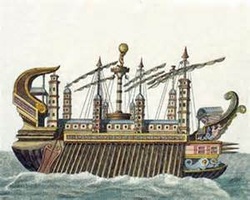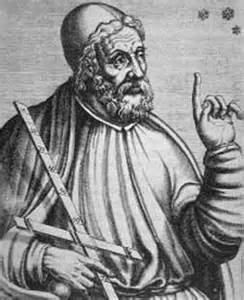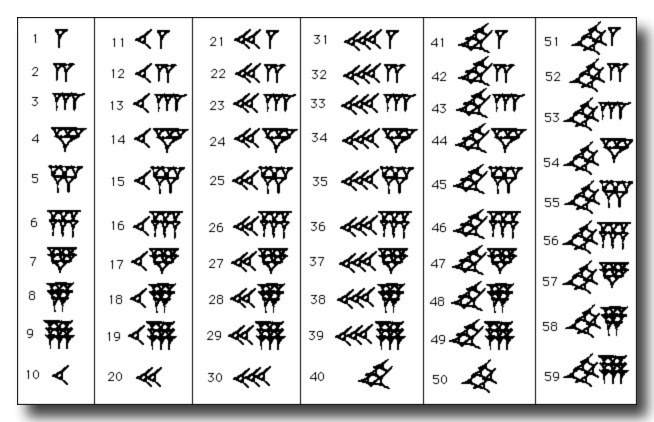
Anchent mathematician and ronound engineer, Archimedes (287-212 BC) was the go to guy for the latest innovations. King Heiro II contracted Archimedes to build the largest ship of the time, the Syracusia. The massive ship was used for luxury, travel, transportation of goods and was even used as a naval war ship. The ship was very luxurious as it accomodated 600 people and incorporated a fully decorated garden, gymnasium and a temple dedicated to the goddess Aphrodite. The ship was so large that Archimedes was faced with the task of keeping it afloat. The ship took on water through it's hull which is located at the very bottom.
To solve this problem, Archimedes invented the water screw (aka screw pump) to bail out water and keep the ship afloat. The pump was operated by hand and very successful, so successful that the simple machine started making it's debut in irigation canals across the world.
The water screw is still commonly used today in coal mines, electricity generation, transportation of grains, etc. Europe uses the water screw in reverse as means of generating electricity. When water flows through the screw from higher levels to lower levels, the weight of the water pushes the blades down and forces the screw to rotate generating electricity. This is a great resource of electricity as it requires no energy input, simply the flow of water and gravity. This machine can also be seen at Seaworld in San Diego on the water ride, the ship wreck rapids.

Brief History
Eudoxus was a Greek astrnonmer and mathematician. Fastenated by the stars, Eudoxus had a passion and interest in Astronomy. At age 23 Eudoxus commuted to Athens to attend the Academy and study with the students of Socrates. With the funding provided by his friends and colleagues, Eudoxus traveled to Africa to persue his study of astronomy and mathematics. After several months in Africa, Eudoxus traveled to the southern shore of the Sea of Marmara where he established his school and gained many pupils of his own. Returing to the Academy with his many of his pupils, Eudoxus lived the rest of his days inspiring brillient minds of math and science, including Aristotle.
Method of Exhaustion
Setting the stage for calculus, Eudoxus derived the theory of exhaustion. The theory of exhaustion is an iterative process that determines the area and volume of shapes by inscribing the shape inside of a regular polygon and with each iterate, double the number of sides of the polygon. As the iterations increase, the difference in area of the nth and (n-1)th terms tend toward a value (the difference gets smaller and smaller until it is negligable.) This method of describing areas set the stage for the limit, however the method of exhaustion does differ from the limit in that exhaustion does not use the notion of "infinity"; instead exhaustion operates with a finite numer of interations (a number that we can count.)
Anchient Mesopotamia
The Greek term Mesopotamia meaning, "land between two rivers: is located between the Tigris and the Euphrates rivers. Today, we know this region as Iraq. Having a mathematical spohisticaton far ahead of their time, the Babylonians famously used the base 60 numeral system, or otherwise known as the sexagesimal numeral system. This unique number system first origionated in the 3rd millennium BC with the Sumerians and was inherited by the Babylons. Fascinated with astronomy and in need of a number system capable of making sophisticated computations, the Babylonians used the base 60 system to create their lunar calendar.
Notation
Base 60 is a positional number system that operates using powers of 60 rather than ten. This means that the base 60 system had 59 units as opposed to our 9, and each base unit has a uique symbolic representation created with the base symbols (INSERT). The former represented multiples of 1 and the latter, multiples of 10. In the decimal system, we use 10 unique base units (including "0") and arrange these units in a particular position in order to represent different numerical values (i.e. 19 and 91 are different in numerical value relative to the base unit's position in the one's and ten's place). Base 60 operates in a similar fashion.
The true reason as to why the mathematically sophisticated Babylonians used the base 60 system is still being studied today, but there is intersting symmetry about this number. For example, 60 has divisior 1, 2, 3, 4, 5, 6, 10, 12, 115, 20, 30 and 60 - in fact, 60 is the smallest integer divisible by all integers from 1 to 6. Today, applications of the base 60 system are commonly associated with time (i.e. 60 minutes per hour, 12 hours in a day, etc.) and agle measures (6 X 60=360 degrees).







 RSS Feed
RSS Feed